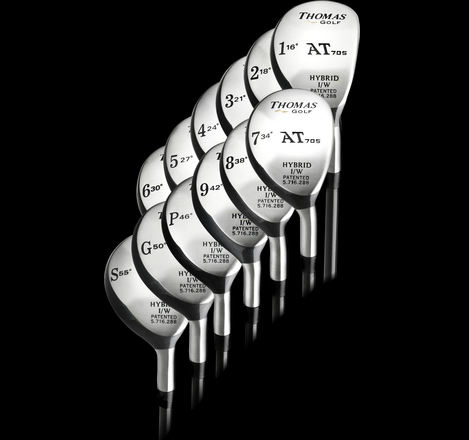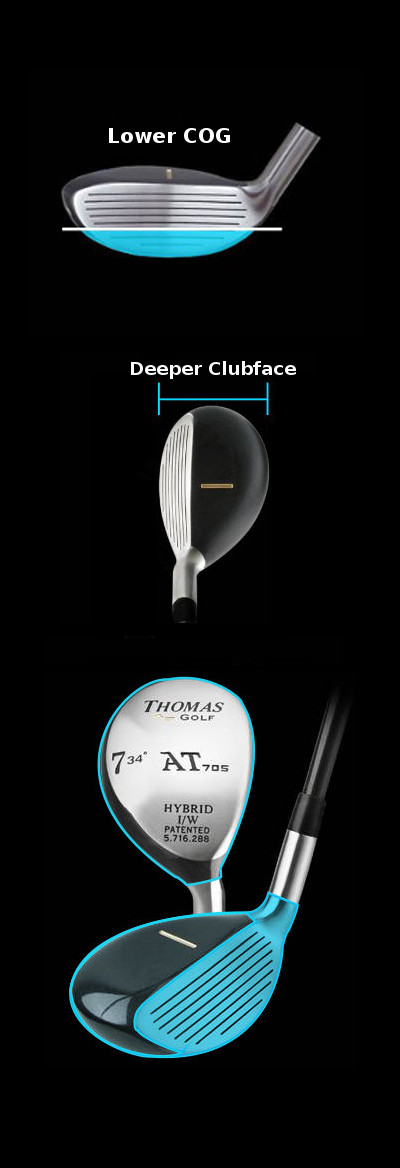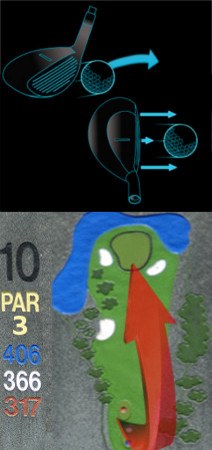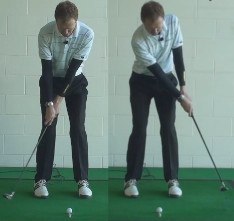
Years ago, golfers had to rely purely on skill (and some luck) in using long irons, which feature thin blades with small sweet spots and very little loft.
Recently, many golfers have been switching to hybrid golf clubs. Also known as hybrid irons, hybrid woods or simply hybrids, these clubs combine the advantages of both irons and fairway woods.
Many PGA Tour players now use hybrid clubs, which manufacturers constantly develop and perfect. It is an understatement to say that hybrids are the future of golf. Below are just some of the reasons to try them yourself:
Straighter shots: Many golfers find hybrids help immensely with accuracy due to the clubs' increased MOI (Moment of Inertia). The clubs have the length of an iron but the larger, shaped head of a fairway wood, making them easier to hit than the traditional long iron.
Versatility: Hybrids are designed to get the ball out of high grass and difficult lies. They're also ideal for players who prefer to sweep the ball off the turf.
Higher, steeper, better: Hybrid irons deliver higher ball flight and a steeper descent than long irons, so shots hold the green better on landing.
Improved contact: Unlike long irons, hybrids assure you of solid contact no matter where the ball is hit on the face.
Less stress: Hybrids are perfect for recreational players who do not want to be too stressed while playing a game.
Since these clubs make shots easier, they make the game much more enjoyable. Nevertheless, many professionals and skilled amateurs use hybrids for lowering their scores.
With all the benefits hybrid clubs offer, a birdie is never too far way.

Top 5 Reasons to Try Hybrid Golf Clubs
Do you have at least one hybrid golf club in your bag? If not, you are among a shrinking population – most golfers have added a hybrid club to their set at this point, and more come on board with this revolution each day. Hybrid clubs offer a great number of advantages to the average golfer. Not just limited to the mid-handicap player, hybrids have also become rather popular on the professional tours. With so much to offer and no notable downsides to think of, you would be wise to consider picking up at least one hybrid for yourself.
In this article, we are going to highlight the top five reasons to try hybrid golf clubs. By the end of this piece, we believe you will have all the motivation you need to get out and give this kind of club a try for yourself. Without any further delay, let's get started!
#1 – Replace Those Dreaded Long Irons
The long irons tend to be a pain point for the average golfer. It is hard to strike a long iron cleanly while swinging with enough speed to lift the ball up into the air. Most amateur long iron shots end in disappointment – either the ball fails to get off the ground at all, or it is sent badly off line. Until recently, you didn't have much of a choice when it came to using long irons. They were the only option for shots of a certain distance, so you simply had to hit them and hope for the best.
Not anymore. Now that there is a plethora of hybrid options on the market, you can toss out some of your long irons in favor of easy-to-hit hybrids. Hybrids are easier to hit than long irons for a number of reasons, including the following –
- Larger club head. As is plain to see simply by looking at the two types of clubs side-by-side, hybrids are larger than long irons. The club heads have a greater volume, which translates to more forgiveness for the golfer. Long irons are punishing when you miss-hit the ball even slightly, meaning you need to achieve a perfect strike if you want to send the ball toward the target. That is not true of hybrids. While it will always be ideal to hit the ball on the sweet spot, of course, missing the center of the face will not usually result in a terrible shot. If you would like to stand over your long shots with a greater degree of confidence, a hybrid club is the right choice.
- Lower center of gravity. This is the advantage which is usually overlooked by the average player. Since a hybrid club will have a hollow head, a larger percentage of the weight can be placed in the sole. Club designers do this on purpose in order to help you get the ball off the ground. The low center of gravity is going to help you get the ball airborne, even when hitting a shot directly off the turf. Hitting a high long iron shot from the fairway is a skill that eludes most golfers, but doing the same thing with a hybrid is a very attainable goal.
- Lighter overall weight. In most cases, a hybrid club will weigh less than a long iron. The result of that lower weight is a faster swing speed, and greater distance in the end. If you struggle to hit your long irons far enough to make them useful to you on the course, your distance problems could potentially be solved by a hybrid or two. When you combine the added swing speed with the ease of getting the ball in the air, you have a powerful combination which can lead to impressive results.
It is common for golfers to start by replacing just one long iron with a hybrid club. However, after they gain some experience with the hybrid and find out just how powerful it can be, most players go on to add at least another hybrid or two. There is no point in carrying a long iron that you are not capable of hitting solidly. Every long iron in your bad which causes you to lose confidence should be tossed out in favor of a more forgiving hybrid.

#2 – Reach Par Five Greens in Two Shots
Have you ever made an eagle? If you have, you already know just how exciting it can be to write down a '3' on your scorecard when playing a par five. Of course, you could also make an eagle on a par four – or even a par three – but those are rare. Most of your chances to make an eagle are going to come on par five holes, and carrying at least one hybrid club will help put you in position to do just that.
After hitting a great drive from the tee of a par five, you are going to have a choice. Are you going to go for the green with your second shot, or are you going to layup? If you don't have much confidence in your long clubs – your long irons, specifically – you will be tempted to just lay the ball up. After all, playing it safe in golf is usually a good way to go. Certainly there is nothing wrong with taking the patient option, but that isn't always going to be the best bet. Sometimes, the best choice is to attack the green, especially when no notable obstacles are in your way. When such an opportunity presents itself, reaching for a hybrid club to handle this shot will give you a great boost of confidence.
Hybrids are great for second shots are par fives because they offer exactly what you are looking for when trying to hit the green from a long distance. First, they provide the player with plenty of distance potential, which is important, of course. Also, they help you get the ball up into the air, which is necessary to stop the ball on the green after it lands. Finally, they are suitable for use from the fairway, and you don't even need to have a great lie to make them work. It still won't be easy to hit the green from long range on a par five, even with the help of a hybrid club, but reaching for a hybrid will give you a needed advantage.
It is important to remember that, even if you have a hybrid to use in this situation, you have to take other factors into consideration before firing away. You don't want to play so aggressively that you wind up wasting strokes for no reason. Go through the following checklist before deciding to attack a par five green with your second shot.
- Can you cover the full distance? Getting the ball close to the green usually won't do you much good, and it might even set up a difficult pitch shot from an awkward distance. Be honest with yourself and decide if you can actually cover the full distance to the target in this situation. If not, it may be best to just lay the ball up to a good distance for your third.
- What could go wrong? The possibility of making an eagle isn't worth taking on a huge degree of risk. For example, if you have to carry most of the distance to the target over water, you probably should opt for the safe route. Sure, you might be able to pull off the shot over water some of the time, but what percentage of those attempts would end up with your ball in the hazard? Taking a penalty shot and a drop is usually going to lead to a bogey, if not worse. Take a look around to see what is between your ball and the hole before deciding if the reward is worth the risk of going for the green.
- Can you hold the green? Even with a hybrid club, it may be hard to hold the ball on the green in some situations. If you can't hold the green, hitting a shot that bounces and rolls over the back of the putting surface might not be any better than just laying up – and it could be much worse. Think about whether or not you believe a good shot will be able to hold the green and then proceed accordingly.
When you decide that the time is right, hitting a hybrid club for the second shot on a par five is an excellent option. Most hybrids provide the player with plenty of lift on the ball, and they are far more forgiving than long irons. If you have not yet made an eagle, this exciting experience could be just around the corner when you start to use your hybrid clubs in this situation.

#3 – Explore a New Option Off the Tee
For most amateur golfers, the process of picking a club to use on a tee shot goes like this – they reach into their bag, grab the driver, and get ready to swing. That's it. The average player doesn't really consider any other options when on the tee of a par four or par five. Sure, they might club down if there is a hazard in the middle of the fairway, but that may be the only circumstance which would force the driver out of their hands.
Needless to say, this is a sub-optimal way of approaching the game. It is great to use your driver in order to move the ball up closer to the green, but only when you have enough room to do so. Based on the design of the course, you will likely encounter several holes during a given round which can be better handled through the use of a shorter club off the tee.
Just as hybrids are excellent for hitting from the fairway on par fives, they are also great for tee shots on holes where a premium needs to be placed on control. For example, if you step up to the tee on a par four which has a fairway lined with bunkers, you should think carefully about leaving your driver in the bag and using the hybrid instead. You are going to give up some distance, of course, but in exchange you will gain significantly more control over your ball. Keeping the ball on the short grass and out of the sand will be worth the loss of distance in most cases.
This strategy is used fairly often on short par fours, but most golfers eliminate it from their way of thinking on longer holes. We would argue that this is a mistake. Even if you have to leave yourself an approach shot of 200-yards or so, hitting that kind of shot from the fairway is better than laying up out of a deep bunker – or hitting your tee shot into a hazard and taking a penalty stroke. Keep an open mind before starting each hole and consider all of your options. Remember, you don't have to be aggressive or conservative on every single hole – you can mix and match your strategy based on the design of the course you are playing. Picking some opportunities to take your chances while you lay back on other occasions is usually the right way to play.
You always want to have as many options as possible while trying to get your ball around the course. If you carry long irons instead of hybrid clubs, you probably won't turn to those to hit tee shots – meaning you will have fewer options at your disposal. By adding a hybrid or two, you'll have another place to turn when you are faced with a narrow fairway.

#4 – Deal with Long Par Threes
If you asked a room full of professional golfers to identify the most difficult type of hole in the game, the majority would point to long par threes. These are tough holes for a variety of reasons. Obviously, you have sheer length to deal with. It is common to see par three holes in the modern game which stretch well beyond 200 yards. In addition to length, the greens used on par three holes are typically rather small – and they may be guarded by sand, long rough, or even water. To be sure, these types of holes are an intimidating challenge.
With a hybrid club in your bag, however, you can take away some of the fear that might be associated with walking to the tee on a long par three. This kind of hole still isn't going to be easy, but you will now stand a fighting chance. For many golfers, hybrid clubs will naturally cover a distance that matches up nicely with many long par threes. Don't be surprised if your own home course has one or two par three holes which fall in the window of distance covered by one of your hybrids.
When using a hybrid club on a par three, it is important to avoid the temptation to tee the ball up well above the turf. Hybrid clubs are meant to be hit off the ground as well as off the tee, so you don't want to put too much air under the ball at address. Doing so will make it likely that you will catch the ball high on the face, leading to a shot which comes up short of the target. Feel free to use a tee to make sure you have a great lie, but only position the ball just barely above the top of the grass.
Also, it is important to pick a smart target when hitting this kind of tee shot. You don't have to aim directly at the hole location each time – in fact, it is usually better if you just aim for the middle of the green regardless of where the hole happens to be cut. A par is a good score on a long par three, and hitting the center of the green should give you a nice opportunity to two putt and move on. If you fall into the trap of aiming for a hole location which is cut near the edge of the putting surface, even a small miss could place your ball in a tricky spot. There is no reason to be so aggressive when all you should be trying to do is finish this hole with a par.
It is still going to be a bit nerve-wracking to walk up to the tee on a long par three, even if you have plenty of hybrid clubs at your disposal. However, it shouldn't be quite as scary as it once was, knowing you now have the right club for the job available. Be smart, pick intelligent targets, and make confident swings. With a quality swing and some help from one of your hybrids, you should be able to make it through the long par threes without too much trouble.

#5 – Gain a Handy Short Game Shot
Perhaps surprisingly, we are going to end our list talking about the short game. While hybrid clubs are predominately used in the long game, they can play a role from time to time in the short game as well. Playing good golf is all about being creative and making the most of the tools you have available. By being open-minded and willing to use your hybrid clubs in particular short game scenarios, you can add a handy new trick to your arsenal.
The shot we are talking about here is basically a bump-and-run. When you find your ball just off the edge of the green – likely sitting on the fringe cut – you can turn to a hybrid club for help. Simply make a putting stroke motion while using your hybrid club, and the ball will pop up barely into the air before rolling out toward the target. This is one of the simplest shots in golf to play, and it is highly effective under pressure. If you have trouble from time to time when chipping with a wedge, this hybrid bump shot can save you strokes right away.
There are a couple things to know about this kind of shot. First, the ball is likely to roll farther than you expect. The hollow design of your hybrid club head is going to pass more energy to the ball than the solid head of your putter. As you make your swing, keep this in mind and be careful to not let the shot get away from you. Of course, it is a good idea to practice this shot before using it on the course, mostly so you can learn how to control your distance.
The other thing to know here is that you only want to use this shot when your ball is just barely off the edge of the green. If you have too much ground to cover before reaching the putting surface, it will be difficult to control your distance properly. The shot is only going to stay in the air for a matter of inches in most cases, meaning you would have to play several bounces off the green if you were farther back. Consider the hybrid when you are near the green's edge and use your wedges otherwise for best results.
It is hard to say enough good things about hybrid clubs. These types of golf clubs have already helped countless players improve their performance, and more and more golfers are getting on board all the time. If you feel like any of the points we have listed in this article would help you reduce your scores, it will be worth your time and effort to try a hybrid out for yourself. Even if you don't buy one right away, ask to 'demo' one at your local driving range just to see what they are like. It may take just a single practice session for you to fall in love with this kind of club. Good luck!






